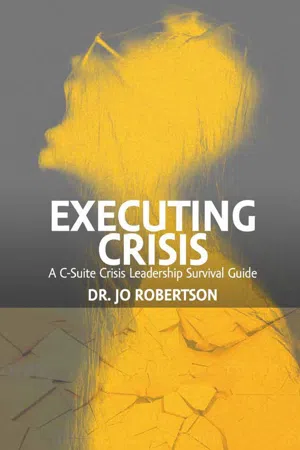![]()
CHAPTER 1
DAY-TO-DAY BUSINESS COMMUNICATION
VS. CRISIS COMMUNICATION
You're a small business owner - you own a little coffee shop in a swanky part of town near a well-known and highly respected university. You have sunk everything you have into this business. You’ve found the best roaster you can, you have yummy snacks and sandwiches. You bought the business from the previous owner, but you’ve staked everything and expanded, and are looking to expand further. Business is good. You’ve got a lot of loyal customers. Your shop has been broken into twice - and it turned out to be a former employee who you fired because he had a drug problem and you caught him stealing. Most often the biggest issue you have had to deal with is a sick employee.
The shop has a great atmosphere, funky university chic. You have five employees, two of whom are full-time, and you pay them well enough to keep them because they’re good people and you can count on both of them to step up when you need them. The others are part-timers, although you have a bit of an issue keeping the part-timers because of the shift work. Still, it’s very close to a family atmosphere. You know all of them well. Some of them, you know their families.
Generally, you open the shop at five each morning, so you’re usually there at 4:30 because you want to have coffee ready when you open the doors to your regulars.
One morning in the spring, you arrive to open up, and things seem a little odd. One of your full-timers, Jim, was scheduled to close up last night, but things don't seem to have been locked up the way they normally would be. Maybe you’re a little angry at Jim when you unlock the door and head toward the back. But then suddenly you know why the lights are still on because right there, next to the cash register, is Jim’s body. You've been trained in CPR, so you check to see if he has a pulse. He does not. Quickly, you check the rest of your shop. Two of your part-timers are also dead. You call 911 and report the crime.
You go outside and sit on the curb, in shock, and wait for the police. You’ve watched enough TV to know that you shouldn't mess with the crime scene any more than you already have.
It’s not your first crisis, but it is likely the biggest you will ever face. Now, cold-blooded as it may seem, you need to communicate. What do you do?
This is not a true story; however, a similar situation did happen, and it’s an example I use in the classes I teach about crisis communications. It happened in a Starbucks in the Georgetown area of Washington, DC. But it also could happen anywhere, and as a corporation, Starbucks has different resources than a small businessperson would. It also happened a decade before the iPhone was introduced, and more than a decade before social media.
You have a crisis on your hands, you need to communicate, and you need to communicate sooner than later. What do you do?
This chapter covers:
- Planning a communications campaign in a day-to-day environment vs. crisis communications.
- Crafting “hip pocket” statements today for the crisis tomorrow.
- Why and how to communicate at the speed of sound.
- Reframing the issue to move forward.
1.1 Everyday Communication vs. Communicating During Crisis
Crisis communications and conventional business communications are different, so it first makes sense to look at how conventional business communications work.
In a day-to-day business environment, communications and public relations team members have the luxury of time to plan out their environment. They’ll strategize how best to market their products and services and how to highlight their wares to best effect. Typically, a marketing plan for a new product launch will include the following standard elements1:
- Situation - what is the situation that led to the conclusion that a PR program was needed?
- Objective - what is the outcome the organization wants to achieve?
- Audience - who is the organization trying to reach? (The more specific, the better. “General public” makes a lousy target audience because identifying what will appeal to such a broad group may render tactics that are scattershot.)
- Strategy - how is the objective going to be achieved? What are the guidelines for the program?
- Tactics - what are the specific activities and sequence to put the plan into operation? (What messages need to be communicated? What vehicles will best get that message to that audience?)
- Budget
- Timetable (or calendar) - plan out how long it will take for each step... as well as when to initiate the campaign
- Measurement criteria - this ties back to the objective. How does the organization determine whether its communication plan was effective (and, if it fell short, what tweaks to the strategy are needed?)
Let’s say, for example, that you’ve decided you want to open a coffee shop in Georgetown, an upscale neighborhood in Washington DC where Georgetown University is located. Perhaps we might sketch out our communications campaign elements something like this:
Situation - You want to open a coffee shop one block off campus that will appeal to Georgetown students.
Objective - to drive Georgetown University students to frequent your coffee shop instead of nearby (and plentiful) competitors. You also intend to have a very aggressive sales objective of matching your competitors’ profits within the first month.
Audience - current students. (Although you certainly won’t turn away nearby residents and business customers, students are the primary audience to which you wish to appeal).
Strategy - You want to become the place where Georgetown University students go to hang out. You want them to swing by first thing in the morning. and to come back between classes. You want them to come in to study or to work on team projects or to relax in the evenings. You want them to bring their friends.
Tactics - What’s going to appeal to this demographic and how do you reach them to share the news about this new outpost? Your seating needs to be comfortable; you need to offer free Wi-Fi and plenty of outlets to recharge phones and laptops, coffee should be good (and fair trade) and not too expensive. You might think about snacks and sandwiches. Perhaps offer live music on Friday evenings. Maybe student art for sale on the walls. And to reach out to them using social media to keep them abreast of upcoming events, product launches and specials. You’ll reward them for liking your shop or introducing someone from their network. Social media can also be a great way to gather metrics. For example, how many customers signed up for and used the coupon. What are people on Yelp! saying?
Budget - Add up the cost of the tactics you’re pitching. Don’t forget to include the cost of the employee time to keep your social media channels fresh.
Timetable - How long will it take to implement this effectively? Will you have everything ready to go on the first day of Fall semester?
Measurement criteria - What were your profits the first month following launch? Did you match the profits of your local competitors? If not, what do you need to tweak to make this communication plan more effective?
But all of this has taken place in a day-to-day environment, where the communications professionals on your team have had the luxury of time to think through and plan out your communications campaign.
It’s a vastly different situation when there’s been a crisis!
1.2 Communicating in Crisis
In the summer of 1997, three employees at a Starbucks coffee shop in Georgetown were murdered overnight.2 It came as a shock to the DC neighborhood, to customers, and employees. I’m sure it was a shock to the Starbucks leadership team as well.
In this case, the coffee shop was well established, not a start-up. And it belonged to the well-known Starbucks chain. But the impact is similar even if the scale is completely different. If this had been your new, startup coffee shop, would it have mattered to your customers that you had comfortable furniture, Wi-Fi, fair trade coffee at reasonable prices? Would your billing of your establishment as the go-to place for Georgetown University students be enough to keep your clientele coming back in the weeks following the incident, or would there be other factors affecting their decision to frequent (or not) your business?
It would stand to reason that security might rise to the top of the list of customer concerns. This was a neighborhood where clientele had never given security a second thought, and at least until the suspects were in custody and motive was sorted out, customers could hardly be blamed for turning elsewhere, right? Why not go back to the competitor down the street, rather than chance it or get involved in making a stand?
So certainly, security is an issue that has to be dealt with head on. But it is not the issue you - as a business leader - want your customers to continue to focus on as the weeks drag on (and especially not after the situation has been resolved). More on that in just a little bit.
The most pressing difference between communicating in a crisis situation is a lack of time to prepare what to say before leadership must begin communicating about the crisis. So let’s talk about that first.
This particular situation happened a decade before the introduction of the iPhone, and the social networking that ensued. Had it happened today, arriving customers would certainly have whipped out their phones to not only take pictures but to broadcast the images and their own take on the “news” as far as their social media channels would take the information. That would have even keener impacts on the coffee shop’s ability to frame the issue or to connect directly with impacted customers.
A generation ago, it was considered best practice for a company in crisis to respond before the next news cycle. Typically (in the United States, at least) that meant the major 6pm or 11pm news broadcasts.
To put that in plainer terms, companies often had the better part of a day to figure out what to say and to polish it up. Twenty years ago, when this event occurred, CNN’s continuous broadcasts had shrunk that news cycle considerably and the rule of thumb for a company in crisis was to begin communicating within one hour. Today, primarily as a result of social media, a company in crisis needs to be prepared to begin communicating immediately or risk loss of control of the message as untrained citizen journalists step in to fill the space with what they believe they have witnessed and often with no real attempt at verification of facts.
As a side note, I often teach classes for business executives who have come to the United States for an intensive week-long course on how business works in this country. After discussion of the Georgetown coffee crisis, I usually ask students how long, if they had been the owners of the business, they think they would have to begin communicating.
“Within 24 hours” invariably is the first answer. Business l...

